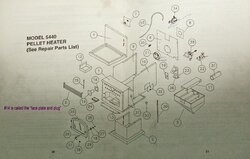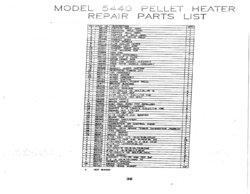My current pellet stove is a 1993 Paragon model 5440 by United States Stove Company which I inherited it from my parents when I moved into my childhood home last year. My husband and I finally started using it last January or February. Found out it was really dirt (really, really diiiiiiiiirty). So, I tore it apart, cleaned it up and it worked beautifully the rest of the season. Although, the perfectionist in me always thought maybe with some other maintenance/repairs (i.e. door and window gaskets, face cap and plug gasket, auger gasket, etc) it could have been made to work even better. At that time, we had neither the money nor the time to rip it apart again but I figured I'd get to it at the beginning of this season.
And, I did... sort of.
I did not rip the whole thing apart again to get to the auger gasket, and didn't replace the face cap gasket either. But I did make an honest attempt to redo the door and window gasket. The only issue was that I didn't know what width of rope gasket I was supposed to use, only that it was wider than the last package of anything they had which was 3/8". So, I waited for their next shipment and bought something wider, 5/8". It also wasn't as wide as I thought I needed but it was the widest they sold and obviously the most popular since I was told they had a hard time keeping it in stock. Anyway, the gasket may or may not be the problem. I honestly don't know because even now, nearly two weeks later, I still haven't done the "dollar bill" test.
And now it may be a moot point because we had a bit of a problem with pellets backing up/jamming the auger. Yesterday morning I could hear the the fan and auger running but the fire had gone out. I thought the hopper was empty, just gave it a quick glance in dim light. I turned the stove off figuring I'd clean it up, fill it, and get it going later. So, when I finally got around to cleaning it I was sufficiently shocked to see one heck of a mess of black (soot?) burn marks and major pile of ash and partially burned pellets inside. The black burn marks were also on the back wall and partially up the shoot. YOWZA!
Ever the procrastinator, and also not wanting my non-handyman husband to miss the "fun" of cleaning it up and solving the problem from the inside out, I waited till evening to get going on the project. Got 'er tore apart and that's all. I figured that after I put the kids to bed, I'd hop online and order all the gaskets I'd wanted to get before plus the proper door and window rope stuff. I did look it all up and have everything ready to go, but haven't completed my order because I don't know if it's the wisest way to go about this. My stove is so old. I worry that the gaskets alone won't be solving my problem and getting replacement parts, if necessary, seems next to impossible.
So, ultimately, here's what I need to know:
Is this thing a dinousaur that's not worth patching up? How much more effecient are pellet stoves these days compared to mine?
It might be helpful to know that the stove is located in the basement which is, for all intents and purposes, unfinished (cement floors, no insulation, lost of stored junk). We do plan on finishing it (except for storage and utility areas) within the next year or so. Still, the stove cranks out enough heat to warm the basement and the rest of the 37 year-old house nicely during the past 30-40 degree days. Our objective is to never have to use the radient heating system which uses an LP gas boiler (I hope I said that right) unless we are seriously going to freeze to death without it. LP gas is highway robbery, IMO. The pellet stove, which my dad installed to replace a big ol'woodstove, is tied into the old chimney and nothing but that, as in nothing special to bring fresh air into the stove (don't know if it's always needed or only in certain circumtances).
Thanks, in advance, for any and all advice. I have nothing but this (or sales people on the floor-uh, no thanks) to consult about this kind of decision since (in my opnion) The Original Pyro Extraordinare a.k.a my dad passed away in January and my husband is clueless (irritating to say the least, but better left to discuss elsewhere and on another day).
And, I did... sort of.
I did not rip the whole thing apart again to get to the auger gasket, and didn't replace the face cap gasket either. But I did make an honest attempt to redo the door and window gasket. The only issue was that I didn't know what width of rope gasket I was supposed to use, only that it was wider than the last package of anything they had which was 3/8". So, I waited for their next shipment and bought something wider, 5/8". It also wasn't as wide as I thought I needed but it was the widest they sold and obviously the most popular since I was told they had a hard time keeping it in stock. Anyway, the gasket may or may not be the problem. I honestly don't know because even now, nearly two weeks later, I still haven't done the "dollar bill" test.
And now it may be a moot point because we had a bit of a problem with pellets backing up/jamming the auger. Yesterday morning I could hear the the fan and auger running but the fire had gone out. I thought the hopper was empty, just gave it a quick glance in dim light. I turned the stove off figuring I'd clean it up, fill it, and get it going later. So, when I finally got around to cleaning it I was sufficiently shocked to see one heck of a mess of black (soot?) burn marks and major pile of ash and partially burned pellets inside. The black burn marks were also on the back wall and partially up the shoot. YOWZA!
Ever the procrastinator, and also not wanting my non-handyman husband to miss the "fun" of cleaning it up and solving the problem from the inside out, I waited till evening to get going on the project. Got 'er tore apart and that's all. I figured that after I put the kids to bed, I'd hop online and order all the gaskets I'd wanted to get before plus the proper door and window rope stuff. I did look it all up and have everything ready to go, but haven't completed my order because I don't know if it's the wisest way to go about this. My stove is so old. I worry that the gaskets alone won't be solving my problem and getting replacement parts, if necessary, seems next to impossible.
So, ultimately, here's what I need to know:
Is this thing a dinousaur that's not worth patching up? How much more effecient are pellet stoves these days compared to mine?
It might be helpful to know that the stove is located in the basement which is, for all intents and purposes, unfinished (cement floors, no insulation, lost of stored junk). We do plan on finishing it (except for storage and utility areas) within the next year or so. Still, the stove cranks out enough heat to warm the basement and the rest of the 37 year-old house nicely during the past 30-40 degree days. Our objective is to never have to use the radient heating system which uses an LP gas boiler (I hope I said that right) unless we are seriously going to freeze to death without it. LP gas is highway robbery, IMO. The pellet stove, which my dad installed to replace a big ol'woodstove, is tied into the old chimney and nothing but that, as in nothing special to bring fresh air into the stove (don't know if it's always needed or only in certain circumtances).
Thanks, in advance, for any and all advice. I have nothing but this (or sales people on the floor-uh, no thanks) to consult about this kind of decision since (in my opnion) The Original Pyro Extraordinare a.k.a my dad passed away in January and my husband is clueless (irritating to say the least, but better left to discuss elsewhere and on another day).



